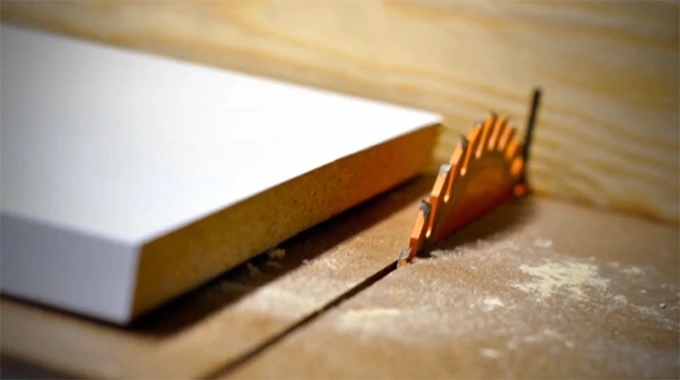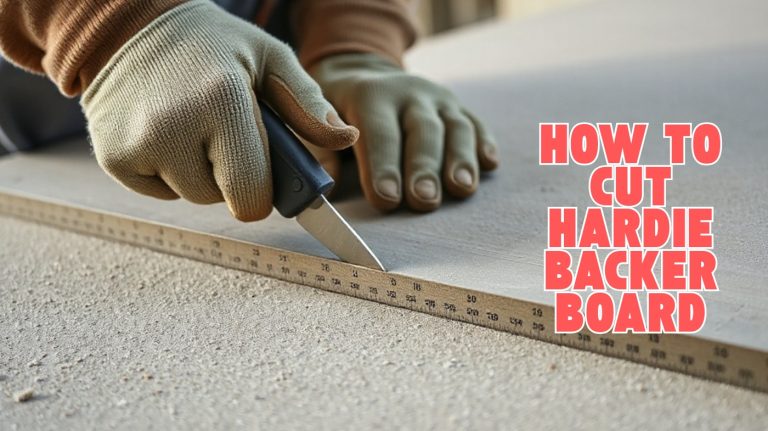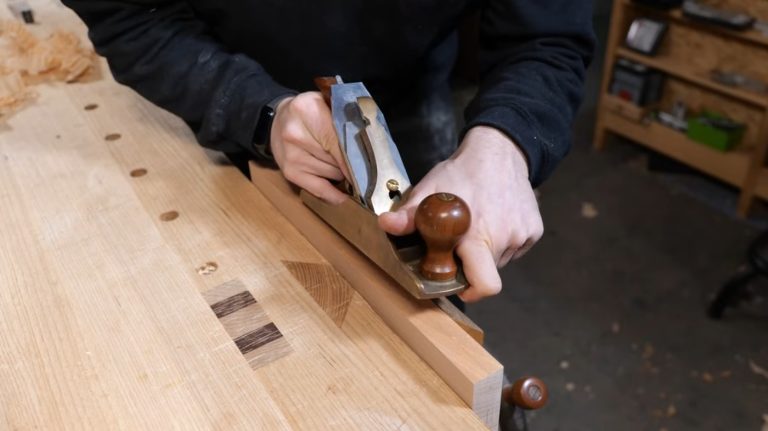How to Finish Teak Wood? Expert Tips for a Lasting Shine
To finish teak wood, start by sanding gently with 80 to 220 grit paper to remove weathered layers and smooth the surface. Clean thoroughly with a mild solution, then apply teak oil evenly using a lint-free cloth.
Let it soak before wiping off excess. For better protection, seal or varnish with multiple thin coats, sanding lightly between each.
Maintain regularly by cleaning and reapplying oil or sealer. Follow these steps carefully to preserve teak’s natural beauty and durability. Explore further to master refinishing and maintenance techniques.
Key Takeaways
- Sand teak wood gradually from 80 to 320 grit for a smooth surface, cleaning dust thoroughly between steps.
- Clean teak with mild soap or specialized cleaners, removing stains carefully using diluted oxalic acid for dark spots.
- Apply teak oil evenly with a lint-free cloth, allowing 15–30 minutes soak time before wiping off excess.
- Use sealers or marine-grade varnishes for enhanced protection, applying multiple thin coats with light sanding between.
- Maintain finished teak by cleaning gently and reapplying oil or sealer annually to preserve color and durability.
Selecting the Right Sandpaper Grit for Teak
When preparing teak wood, choosing the right sandpaper grit is essential to achieve a smooth, even surface without damaging the wood.
Start with 80-grit sandpaper to remove the weathered gray layer and surface buildup effectively. If the teak is heavily stained or weathered, use 60 or 100 grit, but avoid anything coarser than 80 to prevent deep scratches. Always sand with the grain to protect the wood’s natural appearance and maintain control, similar to how a left-handed saw’s ergonomic handle supports precision.
Begin with 80-grit sandpaper to strip weathered layers; use 60 or 100 grit only for heavy staining.
After initial sanding, switch to 150 or 220 grit for smoothing and eliminating coarse sanding marks, revealing teak’s original brown color. This sanding process is safe and does not strip the wood’s protective oils, preserving its natural moisture resistance.
For a professional finish, use finer grits like 320 to 600, especially for indoor pieces. Maintain a gradual progression in grit to avoid uneven sanding and ensure the surface stays smooth and ready for finishing.
Techniques for Cleaning Teak Wood Effectively
When it comes to cleaning teak wood, the first step is to choose a mild cleaning solution or whip up a DIY mix. This way, you can protect the natural oils in your teak and steer clear of any harsh chemicals that might cause damage.
Now, if you need to tackle some pesky stains, you can use diluted oxalic acid. Just remember to apply it carefully and let it sit for about 10 to 20 minutes. After that, give it a good rinse to wash away any residue. It is important to use a nylon or plastic scrubbing brush to avoid damaging the wood fibers during cleaning. Proper maintenance like this helps prevent surface damage and preserves the wood’s natural beauty.
And hey, don’t forget your safety! Always wear protective gear and make sure you have good ventilation while you’re cleaning. It’s all about keeping yourself safe during the process.
Choosing Cleaning Solutions
How do you select the most effective cleaning solution for your teak wood? Start by evaluating the wood’s condition and location. Considering the purpose and application of your teak wood can also guide your choice of cleaner.
For indoor or lightly soiled teak, use a mild soap like Dawn or Murphy Oil Soap mixed with water.
For mildew or outdoor use, consider a vinegar-based solution: equal parts water and white vinegar plus a teaspoon of Dawn per cup.
For heavy soiling or stubborn mold, choose commercial cleaners like ECO-100 powder or ECO-300 liquid, which are eco-friendly and safe for marine environments. Both ECO-100 and ECO-300 are designed specifically for teak decks to be thorough yet gentle.
Always apply cleaners in the shade, use a soft nylon brush scrubbing with the grain, and rinse thoroughly after 15 minutes.
Avoid mixing bleach with ammonia and wear protective gear. Clean teak 2–3 times yearly; match your cleaning solution to the wood’s needs for best results.
Removing Stains Safely
Although teak is naturally resilient, removing stains safely requires careful identification and gentle cleaning methods to preserve its quality.
Start by wiping the surface with a dry cloth to remove dust, then test your chosen cleaner on an inconspicuous spot. Prepare soap solution by mixing natural soap or detergent with water for effective cleaning. Using the appropriate cleaning method also extends the lifespan of woodworking tools.
For water stains, apply mayonnaise in circular motions, let it sit, then wipe clean; use a hair dryer on low to evaporate moisture.
Oil and deep stains need thorough washing with mineral spirits and brushing, followed by sanding from 80- to 220-grit paper to remove embedded residues.
Use oxalic acid paste for dark stains, applying carefully and rinsing afterward.
Always clean with mild detergent solutions and dry thoroughly.
Finish by gently polishing with a smooth edge along the grain to restore color and texture without harsh scrubbing.
Preparing Aged Teak for Refinishing
Before refinishing aged teak, you need to thoroughly assess its condition to guarantee a successful restoration.
Start by inspecting for gray patina, deep stains, cracks, or structural damage. Check moisture levels; excess moisture demands complete drying first. It is also important to regularly check alignment as environmental changes can affect the wood’s shape.
Identify any old finishes or varnishes to determine proper removal methods. Confirm structural integrity, ensuring no loose joints, rot, or insect damage.
Note previous repairs to avoid treatment conflicts.
Clean the surface using mild soapy water and a soft brush, or specialized teak cleaners. This will remove grime and oxidation without stripping oils. It is important to avoid harsh chemicals that can damage the wood’s natural oils and reduce its longevity preserving natural oils.
Rinse thoroughly and allow the wood to dry fully. Sand with medium-grit paper (120–150 grit), then finer grits (220–320 grit), always with the grain. Remove dust and complete minor repairs before final sanding to prepare teak perfectly for finishing.
Applying Teak Oil and Sealers Correctly
When you’re ready to apply teak oil, make sure to do it evenly with a lint-free cloth. A great technique is to use a figure-eight pattern while working with the grain. This not only helps the oil penetrate deeply but also gives you an even finish. Before applying, it’s important to wipe new teak/oily hardwoods with white spirit and let it dry for an even finish. Using a food-safe penetrating oil like pure tung oil can provide excellent water and stain resistance while enhancing the wood grain.
After each coat dries, take a moment to lightly sand the surface if needed. This step is crucial because it prepares the wood for the next layer. Then, apply additional thin layers to build up a durable finish.
To really extend the protection of your teak, consider finishing with a sealer. This will lock in the oils and guard against moisture, while also enhancing the overall appearance and longevity of the wood. It’s a great way to make sure your teak looks fantastic for years to come!
Proper Application Techniques
When applying teak oil or sealers, preparing the surface thoroughly guarantees better absorption and a smoother finish. Start by cleaning the wood, sanding lightly with 220-grit paper along the grain to remove old finish and smooth rough patches.
Use clean, lint-free cloths or quality brushes for even application, and work in a dry, well-ventilated area to avoid inhaling fumes. Proper cleaning and maintenance are essential to prevent surface damage and prolong the wood’s lifespan.
Feel the satisfaction as the oil soaks deep, revealing rich grain and natural warmth. Enjoy the confidence of a flawless finish that protects against moisture and wear.
Experience pride maintaining your teak’s beauty with simple, precise strokes.
Apply oil generously using a figure-eight motion. Let it penetrate for 15–30 minutes, then wipe off excess.
After drying, lightly sand raised grain and apply 2–3 thin coats, allowing adequate drying time between each. For outdoor furniture, reapply every 6–12 months to maintain protection against moisture and UV rays.
Benefits of Sealers
Although teak oil brings out the wood’s natural warmth, applying sealers offers superior protection and longevity for your teak surfaces.
Sealers lock out moisture, preventing water damage and mildew growth while preserving teak’s original color and preventing graying or blackening. Using tools with precision features can help apply sealers evenly for optimal results.
They also inhibit oxidation, maintaining the oil in teak’s outer layer and providing better UV protection than oils.
You’ll find sealers require less frequent reapplication, reducing maintenance time.
When choosing a sealer, pick a quality brand that suits your local environment and offers easy DIY application, like SEMCO, which also comes in various shades to match your teak’s tone.
Regular maintenance with sealers ensures the teak wood retains its natural appearance and structural integrity over many years.
Steps for Varnishing Teak Wood
Before applying varnish to teak wood, you must thoroughly prepare the surface to guarantee ideal adhesion and a flawless finish.
Start by removing old finishes and grease, then sand progressively from 80 to 320 grit along the grain. Clean and brighten gray teak with a specialized teak cleaner before sanding for best results.
Clean off all dust with tack cloths dampened in thinner.
Next, thin your first varnish coat up to 50% for deep penetration and apply evenly with a quality brush, avoiding bubbles. For the first coat on new wood, reduce varnish 25% with thinner to allow better penetration.
After drying fully, build 3–5 coats, sanding lightly between the second and subsequent coats to ensure smoothness and adhesion.
Always remove sanding dust before each layer.
Experience the satisfaction of a silky-smooth, glass-like finish.
Protect your teak’s natural beauty for years.
Witness the wood’s grain deepen and glow with every coat.
Choosing Marine-Grade Varnishes for Durability
After preparing and applying your initial varnish coats, selecting the right marine-grade varnish guarantees your teak wood withstands harsh environmental conditions while maintaining its rich appearance.
Choose varnishes with tung oil or modified polyurethane for enhanced durability and water resistance. Prioritize products with UV-absorbing technology to prevent fading and discoloration caused by sunlight. Marine varnishes provide superior UV protection compared to regular varnishes, making them ideal for outdoor wooden surfaces. Applying varnish in multiple thin coats with proper moisture monitoring ensures better adhesion and longevity.
Opt for tung oil or modified polyurethane varnishes with UV protection to ensure lasting durability and color retention.
Decide between finishes; high gloss varnishes like Epifanes offer a traditional shiny look, while satin finishes such as Cetol provide a flexible, low-sheen alternative.
Consider quick recoat formulas like Total Boat for efficient application. Confirm the varnish accommodates wood expansion without cracking, especially in marine environments exposed to saltwater.
Finally, apply in well-ventilated spaces to minimize VOC inhalation and follow manufacturer guidelines for ideal results.
Maintenance Tips to Prolong Teak Wood Finish
Since teak wood naturally resists decay, maintaining its finish primarily involves regular cleaning and timely reapplication of protective coatings.
Start by gently cleaning with mild soap and a soft-bristle brush. Avoid harsh chemicals or pressure washers that can damage the wood. A homemade cleaning solution of vinegar and warm water can also be effective for restoring the wood’s appearance. Using the right blade selection when cutting teak ensures smoother edges that require less maintenance.
After cleaning, let the teak dry completely before applying teak oil or a sealer. Use a rag or brush for application, wiping off excess to prevent uneven surfaces.
Reapply coatings annually or as needed, especially if the wood is exposed to sunlight, to preserve its rich color and water resistance.
- Feel pride as your teak glows with a lasting, vibrant finish.
- Enjoy peace of mind knowing your care extends its natural beauty.
- Relish the smooth, protective surface guarding against weathering.
Refinishing Strategies for Weathered Teak Furniture
Maintaining your teak wood’s finish keeps it looking vibrant. However, weathered furniture calls for more involved refinishing techniques to restore its beauty and durability.
Start by rinsing gently with water and scrubbing with a soft brush using teak-specific cleaner. Repair cracks with exterior-grade wood filler, then sand thoroughly. Begin with 80 grit, progressing to 220 grit, always sanding with the grain. Using an orbital sander with 220 grit sandpaper can effectively eliminate the gray layer and surface scratches to reveal the wood’s original warmth.
After cleaning and sanding, apply multiple thin coats of teak oil, wiping off excess after 10–15 minutes. Allow drying in a ventilated space between coats.
| Step | Material/Tool | Key Tip |
|---|---|---|
| Cleaning | Soft bristle brush | Avoid high-pressure washers |
| Repair | Teak-colored wood filler | Smooth and dry completely |
| Sanding & Finish | 80–220 grit sandpaper | Sand along grain direction |
Enhancing Rustic Teak With Distressing and Finishing
When you want to give rustic teak furniture a characterful, aged appearance, distressing techniques offer a hands-on way to enhance its natural beauty.
Start by sanding edges and high-contact spots to mimic wear. Then use a hammer or wire brush to add dents and texture. Carefully chisel cracks or drill small wormholes for authentic imperfections. For added dimension, you can also use the sanding technique to remove paint randomly for a weathered effect.
After distressing, lightly sand to highlight grain without erasing marks. Then apply dark stain in grooves to deepen the effect.
Finish with a matte or satin clear coat or teak oil to protect while preserving texture.
Feel the tactile history in every dent and groove.
Watch your teak transform into a story-rich centerpiece.
Experience pride in crafting timeless, rustic charm.
Frequently Asked Questions
Can Teak Wood Be Finished Without Sanding?
Yes, you can finish teak wood without sanding if the surface is intact and lightly weathered.
Start by thoroughly cleaning with a specialized teak cleaner and scrubbing away dirt and mildew.
After rinsing and drying completely, apply teak oil or a protectant using a foam brush, following the grain.
Buff lightly once dry for a smooth finish.
Avoid sanding only if the wood isn’t heavily stained or damaged; otherwise, sanding is necessary.
What Safety Precautions Are Needed When Finishing Teak?
You need to wear chemical-resistant gloves, safety goggles, and a dust mask or respirator to protect your skin, eyes, and lungs from oils, dust, and fumes.
Work in a well-ventilated area, preferably outdoors, and lay down drop cloths to catch spills.
Follow product instructions carefully, avoid direct skin contact, and store chemicals securely.
Dispose of oily rags properly to prevent fire hazards.
Consider using less toxic finishes to minimize environmental impact.
How Long Does Teak Finish Take to Cure Fully?
Think of curing teak finish like baking a slow-cooked stew. It takes patience.
Generally, teak oil can take up to a month to fully cure, especially if applied thickly.
Semco teak sealer dries in about an hour and is ready to use the next day.
Polyurethane finishes usually need 2–3 days for the first coat, with subsequent coats drying in 12–24 hours.
Full hardness often takes about a week, depending on conditions.
Are There Eco-Friendly Finishes Suitable for Teak?
Yes, you can use eco-friendly finishes on teak, like natural oils, linseed, tung, or walnut oil.
These oils penetrate and protect teak without harmful chemicals.
Applying beeswax or carnauba wax over the oil adds a protective, natural layer.
Avoid water-based finishes since teak’s oily nature resists them.
Choose FSC®-certified, low-VOC sealers if you want extra protection.
Regularly clean and oil your teak to keep it beautiful and sustainable.
Can Finished Teak Be Used Outdoors Year-Round?
Imagine your teak wood as a seasoned sailor, built to brave every storm.
Yes, you can use finished teak outdoors year-round because its natural oils and density act like a sturdy ship’s hull, resisting rain, sun, and wind.
To keep it looking sharp, clean it gently and apply teak oil periodically.
This prepares your teak to endure harsh climates without losing its golden charm or strength, ensuring lasting beauty and durability.
Keep Your Teak Timeless: Maintain the Finish Year After Year
Finishing teak wood is like revealing a hidden treasure. Each step polishes its natural beauty and strength. By choosing the right sandpaper grit, cleaning thoroughly, and applying oil or marine-grade varnish with care, you’ll create a durable, radiant finish.
Treat your teak like a living canvas. Maintain it regularly to keep its glow alive. With these precise techniques, your teak will stand proud, weathering time while showcasing timeless elegance.







